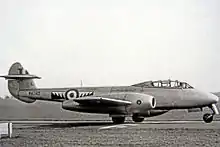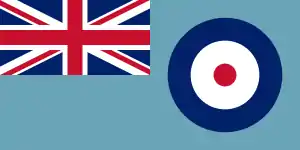No. 610 Squadron RAF
No. 610 (County of Chester) Squadron of the Royal Air Force was a Squadron of the Auxiliary Air Force. Comprising very high quality pilots, often ex-RAF officers and occasionally locally based company Test pilots from companies such as de Havilland and Airwork. Its pilots were initially part timers who would spend their weekends and spare time flying and practising combat manoeuvres. The squadron was named the "County of Chester" and adopted the motto "Alifero tollitur axe ceres"; which translates as "Ceres rising in a winged chariot". Ceres being the Roman Goddess of Wheat, a reference to Chester's Agricultural sector. Its badge contained the image of a garb (sheaf of wheat).
| No. 610 (County of Chester) Squadron RAF | |
|---|---|
| Active | 10 February 1936 – 3 March 1945 10 May 1946 – 10 March 1957 |
| Country | |
| Branch | |
| Part of | Royal Auxiliary Air Force |
| Motto(s) | Latin: Alifero tollitur axe ceres (Translation: "Ceres rising in a winged chariot")[1] |
| Engagements | Battle of Britain |
| Commanders | |
| Honorary Air Commodore | Sir William Bromley-Davenport(1937–49) I.R. Parker (1953–57) |
| Notable commanders | J.E. "Johnnie" Johnson, Cyril Stanley Bamberger |
| Insignia | |
| Squadron Badge heraldry | A garb, divided into two parts and coloured red and blue A wheatsheaf was chosen as such charges appear in the armorial bearings of the city of Chester; No. 610 Squadron was the County of Chester Squadron[2] |
| Squadron Codes | JE (Apr 1939 – Sep 1939)[3] DW (Sep 1939 – Mar 1945, 1949 – Apr 1951)[4] RAQ (May 1946 – 1949)[5] |
| Post-1950 squadron roundel |  |
610 Squadron Association, with headquarters at Hooton Park, has a substantial number of ex-members of the Squadron on its list of members.
History
Formation and early years
The squadron was formed on 10 February 1936 at Hooton Park, Wirral, Cheshire as one of the Auxiliary Air Force Squadron. It was equipped with Hawker Hart light bombers. As war approached, these were replaced by Hawker Hinds in May 1938. On 1 January 1939 the squadron role was changed into that of a fighter squadron, and on the outbreak of war in September 1939 it received its first Hawker Hurricane fighters. By the end of that same month it was flying the more advanced Supermarine Spitfire fighter.
Second World War

610 Squadron was attached to No. 13 Group RAF during the Battle of Britain. It had initially been based at RAF Gravesend, but moved to RAF Biggin Hill before the German offensive began and was one of the units bearing the brunt of German attacks. It moved to RAF Acklington for rest and recuperation at the end of August, having sustained severe casualties. During the Battle of Britain the squadron included Pilot Officer, later Squadron Leader, Constantine Pegge.
In 1941, the squadron moved south to RAF Westhampnett where it was one of Douglas Bader's three Spitfire squadrons of the Tangmere wing. It remained based in the UK until late 1944 when it moved to the Continent to provide fighter cover as the allies entered Germany. 610 Squadron was disbanded before the end of the war at RAF Warmwell on 3 March 1945.
Post-war

The squadron was re-formed on 10 May 1946 at RAF Hooton Park as a Royal Auxiliary Air Force fighter squadron, embodied in June of that year and receiving its first Spitfire F.14s in November 1946, switching to more powerful Spitfire F.22s in March 1949. Gloster Meteor F.4 jet fighters were received in July 1951, being replaced by the later F.8 version in March 1952. Meteor T.7 twin-seat training aircraft were also used as advanced conversion trainers. The Meteors were flown until shortly before the squadron disbanded on 10 March 1957, together with all other RAuxAF flying units.[6]
Aircraft operated
| From | To | Aircraft | Version |
|---|---|---|---|
| March 1936 | May 1938 | Hawker Hart | |
| May 1938 | September 1939 | Hawker Hind | |
| September 1939 | September 1939 | Hawker Hurricane | Mk.I |
| September 1939 | February 1941 | Supermarine Spitfire | Mk.I |
| February 1941 | July 1941 | Supermarine Spitfire | Mk.IIa |
| July 1941 | August 1941 | Supermarine Spitfire | Mk.Vb |
| August 1941 | November 1941 | Supermarine Spitfire | Mks.IIa, IIb |
| November 1941 | March 1944 | Supermarine Spitfire | Mks.Vb, Vc |
| December 1943 | March 1945 | Supermarine Spitfire | Mk.XIV |
| November 1946 | April 1949 | Supermarine Spitfire | F.14 |
| March 1949 | August 1951 | Supermarine Spitfire | F.22 |
| July 1951 | May 1952 | Gloster Meteor | F.4 |
| March 1952 | February 1957 | Gloster Meteor | F.8 |
Squadron bases
| From | To | Base |
|---|---|---|
| 10 February 1936 | 10 October 1939 | RAF Hooton Park, |
| 10 October 1939 | 4 April 1940 | RAF Wittering, Cambridgeshire |
| 4 April 1940 | 10 May 1940 | RAF Prestwick, Ayrshire, Scotland |
| 10 May 1940 | 27 May 1940 | RAF Biggin Hill, Kent |
| 27 May 1940 | 8 July 1940 | RAF Gravesend, Kent |
| 8 July 1940 | 31 August 1940 | RAF Biggin Hill, Kent |
| 31 August 1940 | 15 December 1940 | RAF Acklington, Northumberland |
| 15 December 1940 | 29 August 1941 | RAF Westhampnett, West Sussex |
| 29 August 1941 | 14 January 1942 | RAF Leconfield, Yorkshire |
| 14 January 1942 | 4 April 1942 | RAF Hutton Cranswick, Yorkshire |
| 4 April 1942 | 16 August 1942 | RAF Ludham, Norfolk |
| 16 August 1942 | 21 August 1942 | RAF West Malling, Kent |
| 21 August 1942 | 15 October 1942 | RAF Ludham, Norfolk |
| 15 October 1942 | 20 January 1943 | RAF Castletown, Caithness, Scotland |
| 20 January 1943 | 30 April 1943 | RAF Westhampnett, West Sussex |
| 30 April 1943 | 26 June 1943 | RAF Perranporth, Cornwall |
| 26 June 1943 | 19 December 1943 | RAF Bolt Head, Devon |
| 19 December 1943 | 4 January 1944 | RAF Fairwood Common, Glamorgan, Wales |
| 4 January 1944 | 7 April 1944 | RAF Exeter, Devon |
| 7 April 1944 | 23 April 1944 | RAF Culmhead, Somerset |
| 23 April 1944 | 30 April 1944 | RAF Fairwood Common, Glamorgan, Wales |
| 30 April 1944 | 16 May 1944 | RAF Culmhead, Somerset |
| 16 May 1944 | 29 May 1944 | RAF Bolt Head, Devon |
| 29 May 1944 | 19 June 1944 | RAF Harrowbeer, Devon |
| 19 June 1944 | 27 June 1944 | RAF West Malling, Kent |
| 27 June 1944 | 2 July 1944 | RAF Westhampnett, West Sussex |
| 2 July 1944 | 12 September 1944 | RAF Friston, Suffolk |
| 12 September 1944 | 4 December 1944 | RAF Lympne, Kent |
| 4 December 1944 | 31 December 1944 | B.56/Evere, Belgium |
| 31 December 1944 | 27 January 1945 | Y.32/Ophoven, Belgium |
| 27 January 1945 | 21 February 1945 | B.78/Eindhoven, Netherlands |
| 21 February 1945 | 3 March 1945 | RAF Warmwell, Dorset |
| 10 May 1946 | 10 March 1957 | RAF Hooton Park, Cheshire |
Commanding officers
| From | To | Name |
|---|---|---|
| 10 February 1936 | December 1939 | S/Ldr. I.R. Parker |
| January 1940 | 29 May 1940 | S/Ldr. A.L. Franks, AFC |
| 29 May 1940 | July 1940 | S/Ldr. A.T. Smith |
| July 1940 | April 1941 | S/Ldr. J. Ellis, DFC & Bar |
| April 1941 | June 1941 | S/Ldr. H. de C.A. Woodhouse, AFC |
| June 1941 | 4 November 1941 | S/Ldr. K. Holden, DFC |
| 4 November 1941 | December 1941 | S/Ldr. B.J. Wicks, DFC |
| December 1941 | February 1942 | S/Ldr. C.O.J. Pegge, DFC |
| February 1942 | July 1942 | S/Ldr. G.S.K. Haywood |
| July 1942 | March 1943 | S/Ldr. J.E. Johnson, DFC & Bar |
| March 1943 | January 1944 | S/Ldr. W.A Laurie, DFC |
| January 1944 | February 1945 | S/Ldr. R.A. 'Dickie' Newbery,[10] DFC & Bar |
| February 1945 | March 1945 | F/Lt. Shepherd |
| June 1946 | March 1948 | S/Ldr. P.G. Lamb, AFC |
| March 1948 | 1950 | S/Ldr. R.D. Graesser |
| 1950 | 1952 | S/Ldr. C.S. Bamberger, DFC & Bar |
| 1952 | 1954 | S/Ldr. H.C. Rigby |
| 1954 | 10 March 1957 | S/Ldr. J.E. Storrar, DFC & Bar, AFC |
References
Notes
- Halley 1988, p. 427.
- Rawlings 1978, p. 495.
- Bowyer & Rawlings 1979, p. 14.
- Bowyer & Rawlings 1979, p. 31.
- Bowyer & Rawlings 1979, p. 138.
- Jefford 2001, p. 100.
- Rawlings 1978, p. 496.
- Hunt 1972, pp. 227–245.
- "No. 610 (County of Chester) Squadron website". Archived from the original on 4 December 2008. Retrieved 20 March 2010.
- Thomas, Andrew (20 September 2013). V1 Flying Bomb Aces. Bloomsbury Publishing. ISBN 978-1-78096-293-1.
Bibliography
- Bowyer, Michael J.F.; Rawlings, John D.R. (1979). Squadron Codes, 1937–56. Cambridge, UK: Patrick Stephens Ltd. ISBN 0-85059-364-6.
- Flintham, Vic; Thomas, Andrew (2003). Combat Codes: A Full Explanation and Listing of British, Commonwealth and Allied Air Force Unit Codes since 1938. Shrewsbury, Shropshire, UK: Airlife Publishing Ltd. ISBN 1-84037-281-8.
- Halley, James J. (1988). The Squadrons of the Royal Air Force & Commonwealth, 1918–1988. Tonbridge, Kent, UK: Air-Britain (Historians) Ltd. ISBN 0-85130-164-9.
- Hunt, Leslie (1972). Twenty-One Squadrons: The History of the Royal Auxiliary Air Force, 1925–1957. London: Garnstone Press. ISBN 0-85511-110-0.
- Jefford, C.G. (2001). RAF Squadrons, a Comprehensive record of the Movement and Equipment of all RAF Squadrons and their Antecedents since 1912 (2nd ed.). Shrewsbury, Shropshire, UK: Airlife Publishing Ltd. ISBN 1-85310-053-6.
- Moyes, Philip J.R. (1976). Bomber Squadrons of the RAF and their Aircraft. London: Macdonald and Jane's (Publishers) Ltd. ISBN 0-354-01027-1.
- Rawlings, John (1978) [1969]. Fighter Squadrons of the RAF and their Aircraft (Revised ed.). London: Macdonald and Jane's Publishers Ltd. ISBN 0-354-01028-X.
- Robinson, Anthony (1999) [1987]. RAF Squadrons in the Battle of Britain. London: Brockhampton Press. ISBN 1-86019-907-0.
External links
| Wikimedia Commons has media related to No. 610 Squadron RAF. |
